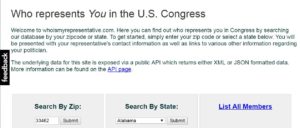How to Be Heard by Legislators about Proposed NIH Budget Cuts
Your senators and congressional representatives want to hear their constituents. They have fairly specific channels they use to estimate the weight of opinion from residents of their districts: 1) phone calls, 2) visits to district/national office(s), 3) letters, and 4) local meetings. The last is getting harder to read. Bet on the former.
Here’s the plan:
- Identify your legislators and their contact information at whoismyrepresentative.com
- Call when you have time to be on hold.
- While you are waiting, Google the address of the district office for each of your legislators. The website above has DC addresses which are slightly less potent.
- Have your talking points ready (see below). However recognize that you may not get to them in if staff are counting calls by content, a process similar to a yeah or nay poll.
Draft your letters with a similar script:
Who you are:
I am in my third year on faculty at [Important University in Your State]. (Of course I don’t officially represent the university and am sharing my personal views.)
What you study, in plain language:
I study what makes some people much less likely than others to get Alzheimer’s disease using genetics and brain imaging like MRI. We aim to find an approach to prevention.
Current relationship to NIH:
I have an NIH early career award. The federal government has already invested more than $350,000 in helping launch my career and my research team has made breakthroughs.
Remind the staffer that funding is based on merit:
Fewer than one in three scientists who apply receive these awards. I say that to emphasize that researchers do compete to get their research funded.
State what reduction in funding could mean for you and/or your institution:
In the next step of my career, I am currently facing 1 in 5 odds that my NIH proposals will be funded. Less available funding could make this challenge unwinnable for me and for my colleagues.
Closer (your take home message with passion):
The loss of investment in great science and promising investigators will be stunning if the NIH budget is cut.
Offer to stay in touch (scientists on the record are hard to find):
Please feel free to contact me if you need specific stories to make this point.
Email volume is overwhelming and most legislative offices do not have enough staff to sort out signal from noise. Ditto Facebook, Twitter, etc. Even if the legislator has a social media presence, the staff work primarily to control flaming and don’t use comments or messages as data about their base.
In contrast, calls and letters are logged and that makes them potent. Block off time on your calendar for calls as it gets closer to the active consideration of the NIH budget and make those calls. Scientists are making a difference.






3 Comments
Hey Boss,
So I guess I just want to chime to reiterate that calling your legislators is absolutely the best thing to do. It’s a PitA, but calls are logged and tallied. Snail mail letters can take weeks to arrive since they have to undergo extra screening for Anthrax and whatnot (not kidding).
I heard a TN lobbyist talk about the power of not just getting someone one the phone, but then asking them when open office hours are. Every rep has them. You go to their office in your Sunday best, get to talk to a staffer (and sometimes a rep!) for 15 min or so and state your point.
There is also no point at all trying to talk to someone who does not represent you. Calling Paul Ryan if you don’t live where he does is useless.
Great post! Great hair! Great website!
I thought this New Yorker piece that came out recently was also good peek into how various methods of contacting your congresspeople are viewed and responded to: What Calling Congress Actually Achieves. This was the most interesting part for me:
“According to a 2015 C.M.F. survey of almost two hundred senior congressional staffers, when it comes to influencing a lawmaker’s opinion, personalized e-mails, personalized letters, and editorials in local newspapers all beat out the telephone.
“In normal times, then—which is to say, in the times we don’t currently live in—calling your members of Congress is not an intrinsically superior way to get them to listen. But what makes a particular type of message effective depends largely on what you are trying to achieve. For mass protests, such as those that have been happening recently, phone calls are a better way of contacting lawmakers, not because they get taken more seriously but because they take up more time—thereby occupying staff, obstructing business as usual, and attracting media attention.”
Great information and a fantastic read. Likely somewhat dependent on size of staff, size of constituency, and office protocols. Upsides and downsides to both letters and calls. As Fighty Squirrel notes, delay for screening of letters kicks in when there is a time crunch. In this case the academic research community has time to stay ahead of the curve and mail is also counted/logged. Best: Do both (call and write) and personalize your message while providing factual information.
More out-takes: “For constituent activity to have more immediate effects on the actions of lawmakers, however, other condition…must apply. Broadly speaking, these include a huge quantity of people acting in concert, an unusually high pitch of passion, a specific countervailing vision, and consistent press coverage unfavorable to sitting politicians.”
“Still, if the calls are coming in at forty an hour,” Moore said, “something interesting is happening. If a member of Congress is presented at the end of the day with around six hundred to a thousand unique calls, I’d call that a flood.”
Take home: Participate and get others on board. Preserving the NIH budget and retaining talented scientists to drive discovery will take concerted action.